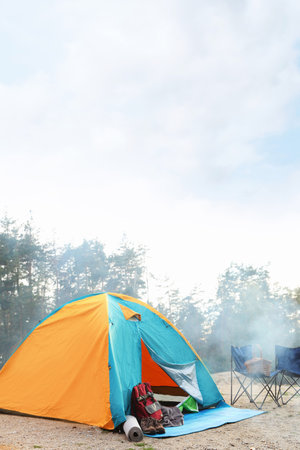1. Understanding Lumens: The Brightness Factor
When youre shopping for a camping flashlight, one of the first specs youll see is “lumens.” But what exactly does that mean? Simply put, lumens measure the total amount of visible light a flashlight produces. The higher the lumens, the brighter the flashlight. But brighter isn’t always better—it really depends on how you plan to use your light in the great outdoors.
What Do Lumens Measure?
Lumens measure brightness at the source. It doesn’t factor in how far the beam goes or how focused it is—that’s where beam distance comes in. For now, think of lumens as a measure of how much light youre getting overall. Whether youre trying to light up your entire campsite or just need a soft glow inside your tent, understanding lumens helps you pick the right tool for the job.
How Many Lumens Do You Really Need?
The number of lumens you need depends on your camping activities. Here’s a quick guide to help you figure out what level fits your needs:
| Lumen Range | Best For |
|---|---|
| 20 – 100 lumens | Close-up tasks like reading or cooking at camp |
| 100 – 300 lumens | Walking around camp or lighting up a small area |
| 300 – 600 lumens | Hiking trails at night or navigating in low-light conditions |
| 600+ lumens | Long-distance visibility or emergency signaling |
Lumens vs. Battery Life
Keep in mind that more lumens usually means faster battery drain. So if youre heading out on a multi-day trip without access to charging options, you might want a flashlight with adjustable brightness settings. That way, you can use high lumens when needed and switch to lower modes to conserve power.
Pro Tip:
If your flashlight has multiple brightness settings, you get more flexibility while saving battery life. Look for models with “low,” “medium,” and “high” modes—or even better, customizable brightness levels.
Bottom Line:
Lumens are key to understanding how bright your flashlight will be. Choose based on your specific camping needs—not just the highest number on the package.
2. Beam Distance Explained
When youre shopping for a camping flashlight, one of the specs youll often see is “beam distance.” But what does that really mean when youre out in the woods or hiking across open terrain? Simply put, beam distance tells you how far the light from your flashlight can reach before it dims to the brightness of a full moon on a clear night (about 0.25 lux). That level of light is generally considered just enough for safe navigation.
How Is Beam Distance Measured?
The beam distance rating is based on standardized testing, usually using ANSI FL1 guidelines. These tests measure how far the flashlights beam will travel in optimal conditions—like in total darkness with fresh batteries. Keep in mind that real-world conditions like fog, trees, and terrain can affect actual performance.
Beam Distance vs. Brightness
It’s easy to confuse brightness (measured in lumens) with beam distance, but they’re not the same thing. A flashlight can have high lumens but a short beam distance if its light spreads out wide rather than focusing into a tight beam.
| Flashlight Type | Lumens | Beam Distance | Best For |
|---|---|---|---|
| Compact Headlamp | 150 lm | 40 meters | Close-up tasks, inside tent |
| General Camping Flashlight | 300 lm | 100 meters | Walking trails, around campsite |
| High-Powered Spotlight | 1000+ lm | 300+ meters | Open terrain, search and rescue |
Choosing the Right Beam Distance for Your Environment
Open Terrain Camping
If youre camping in areas like deserts, plains, or mountaintops where visibility is wide open, go for a flashlight with a longer beam distance—at least 200 meters. This helps you spot landmarks or wildlife from far away.
Wooded Trails and Dense Forests
In heavily wooded or brush-filled areas, light tends to scatter due to obstacles like trees and leaves. A flashlight with a moderate beam distance (around 50–100 meters) and a wider beam angle works better here since you need more coverage up close rather than long-range visibility.
Quick Tip: Match Beam Distance With Activity Type
| Activity | Recommended Beam Distance |
|---|---|
| Tent Setup & Cooking | < 50 meters |
| Campsite Patrol & Short Hikes | 50–100 meters |
| Night Hiking & Navigation | 100–200+ meters |
| Emergency Search or Signaling | 200+ meters |
Selecting the right beam distance isn’t about picking the brightest light—it’s about choosing what fits your surroundings and needs best. Whether youre navigating thick woods or scanning wide-open fields, understanding how far your flashlight can reach helps keep you safe and prepared.

3. Spot vs. Flood: Choosing the Right Beam Type
When youre shopping for a camping flashlight, understanding the beam type is just as important as brightness or battery life. Flashlights typically come with either a spot beam, a flood beam, or sometimes both in a dual-beam setup. Each has its own advantages depending on your camping activity.
What’s the Difference?
The main difference between spot and flood beams comes down to how the light is projected:
| Beam Type | Description | Best For |
|---|---|---|
| Spot Beam | Narrow, focused light that reaches far distances | Night hiking, searching for trails, long-distance visibility |
| Flood Beam | Wide-angle light that covers a large area nearby | Setting up tents, cooking at camp, general campsite use |
Choosing Based on Your Camping Needs
Trail Hiking or Night Trekking
If you’re planning to hike after sunset or navigate unfamiliar trails in low light, a spot beam is your best bet. The concentrated beam helps you see far ahead, which is crucial for avoiding obstacles and staying on course.
Camp Setup and Close-Up Tasks
For tasks like pitching your tent, preparing meals, or hanging out around the fire pit, a flood beam gives you broad coverage so you can see everything around you without harsh shadows or blind spots.
Why Not Both?
Some high-quality camping flashlights offer both spot and flood modes. These are great if you want one flashlight that can do it all — just switch modes depending on what youre doing.
Quick Comparison Chart
| Activity | Recommended Beam Type |
|---|---|
| Trail hiking at night | Spot Beam |
| Campsite setup | Flood Beam |
| Reading inside tent | Flood Beam (low brightness) |
| Searching for gear in the dark | Spot Beam or Dual-Beam |
Selecting the right beam pattern helps make your camping experience safer and more enjoyable. Think about how youll use your flashlight most often and choose a model that fits your needs.
4. How Brightness and Beam Distance Work Together
When shopping for a camping flashlight, its easy to assume that higher lumens mean a better light. But brightness (measured in lumens) and beam distance don’t always go hand in hand. Understanding how these two specs interact can help you choose the right flashlight for your outdoor adventures.
Brightness vs. Beam Distance: What’s the Difference?
Brightness refers to how much light a flashlight emits overall, while beam distance measures how far that light can reach effectively. A flashlight with high lumens might flood a wide area with light but not project it very far. On the other hand, a focused beam with fewer lumens can still shine far into the distance.
Quick Comparison Table
| Feature | High Lumens, Short Distance | Lower Lumens, Long Distance |
|---|---|---|
| Beam Type | Flood Beam (Wide) | Spot Beam (Focused) |
| Best For | Campsite lighting, close-range tasks | Navigating trails, spotting wildlife at a distance |
| Battery Usage | Drains faster due to higher output | More efficient if beam is narrow and focused |
| Visibility Range | Short to medium range | Long-range visibility |
Why More Lumens Isn’t Always Better
A common misconception is that more lumens automatically make a flashlight superior. But in real-world camping situations, efficiency and usability matter more than raw power. A 1000-lumen flashlight might look impressive on paper, but if it spreads the light too broadly or drains batteries quickly, it might not serve you well on a multi-day hike.
The Role of Lens Design and LED Focus
The design of the reflector or lens plays a big role in how effectively a flashlight uses its lumens. A well-designed reflector can focus even moderate brightness into a tight beam that travels farther than an unfocused high-lumen light. This is why two flashlights with similar lumen ratings can perform very differently in the field.
Pro Tip:
Look at reviews or beam pattern diagrams when available. These often show real-world performance better than just relying on numbers alone.
Choose Based on Use Case
If you mostly stay around camp and need broad lighting for cooking or setting up gear, go for a high-lumen floodlight. But if youre hiking in the dark or scouting trails, a lower-lumen spotlight with strong beam distance will serve you better—and save battery life too.
The key takeaway? Don’t just chase high lumen numbers. Consider how beam distance, focus, and your actual camping needs work together to find the most practical and efficient flashlight for your next trip.
5. Real-World Application: Choosing the Right Flashlight for Your Trip
Now that you understand how beam distance and brightness work, its time to put that knowledge into action. Different types of camping trips require different flashlight features. Lets break down what to look for depending on your adventure.
Backpacking
When youre hitting the trail with everything on your back, weight and battery life are top priorities. Youll want a lightweight flashlight or headlamp with decent brightness (100–300 lumens is usually enough) and long battery life. Rechargeable options are great if you have a power bank or solar charger.
Key Features:
- Lightweight design
- Rechargeable battery
- Moderate beam distance (50–100 meters)
- Water-resistant (IPX4 or higher)
Car Camping
With more space and access to your vehicle, you can afford to bring a larger, brighter flashlight. These are great for lighting up a big campsite or walking trails at night. Look for something with at least 300 lumens and multiple lighting modes.
Key Features:
- High brightness (300+ lumens)
- Long beam distance (100+ meters)
- Durable build
- Option for alkaline or rechargeable batteries
Survival Situations
If youre prepping for emergencies, you need a flashlight thats tough, reliable, and long-lasting. Brightness matters, but durability and power management matter more. Tactical flashlights with strobe modes can also be helpful in distress situations.
Key Features:
- High durability (aluminum body, impact-resistant)
- Long runtime on low modes
- Multiple lighting modes including SOS/strobe
- Weatherproof (IPX6 or higher)
Family Outings
For casual camping trips with kids or groups, user-friendly flashlights are key. You don’t need extreme brightness, but having a few lights to go around is smart. Look for easy-to-use models with simple controls and safe designs.
Key Features:
- User-friendly interface
- Mild to moderate brightness (150–300 lumens)
- Dimmable settings to avoid blinding others
- Splash-proof and durable enough for kids
Quick Comparison Table
| Trip Type | Lumens Range | Recommended Beam Distance | Top Priorities |
|---|---|---|---|
| Backpacking | 100–300 lumens | 50–100 meters | Lightweight, battery life, water resistance |
| Car Camping | 300–800 lumens | 100+ meters | Brightness, multiple modes, durability |
| Survival/Emergency Use | 200–1000+ lumens | Varies by mode | Tough build, long runtime, weatherproofing |
| Family Outings | 150–300 lumens | 30–80 meters | User-friendly, safety, basic water resistance |
The right camping flashlight depends on where youre going and what youre doing. By comparing specs like beam distance and brightness with real-world needs like battery life and ease of use, youll find the perfect light for your next outdoor adventure.


